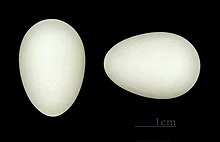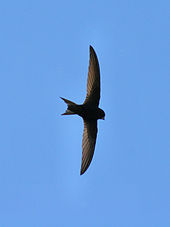Common swift
| Common swift | |
|---|---|

| |
| In Barcelona, Spain | |
| Scientific classification | |
| Domain: | Eukaryota |
| Kingdom: | Animalia |
| Phylum: | Chordata |
| Class: | Aves |
| Clade: | Strisores |
| Order: | Apodiformes |
| Family: | Apodidae |
| Genus: | Apus |
| Species: | A. apus
|
| Binomial name | |
| Apus apus | |

| |
| Range of A. apus Breeding range Wintering range
| |
| Synonyms | |
|
Hirundo apus Linnaeus, 1758 | |
The common swift (Apus apus) is a medium-sized
Its scientific name Apus is Latin for a swift, thought by the ancients to be a type of swallow with no feet (from Ancient Greek α, a, "without", and πούς, pous, "foot").[3]
Swifts have very short legs which they use primarily for clinging to vertical surfaces (hence the German name Mauersegler, literally meaning "wall-glider"). They never settle voluntarily on the ground where they would be vulnerable to accidents and predation, and non-breeding individuals may spend up to ten months in continuous flight.[4]
Taxonomy
The common swift was one of the many species described by the Swedish naturalist
A Central European
Description
Common swifts are 16–17 cm (6.3–6.7 in) long with a wingspan of 38–40 cm (15–16 in)[8] and entirely blackish-brown except for a small white or pale grey patch on their chins which is not visible from a distance. They have a short forked tail and very long swept-back wings that resemble a crescent or a boomerang.
Their call is a loud scream in two different tone pitches, the higher of which issues from the female. They often form "screaming parties" during summer evenings, when 10–20 swifts will gather in flight around their nesting area, calling out and being answered by nesting swifts. Larger "screaming parties" are formed at higher altitudes, especially late in the breeding season. The purpose of these parties is uncertain, but may include ascending to sleep on the wing, while still breeding adults tend to spend the night in the nest.[citation needed] Tracking swifts at their breeding colonies using radar has revealed that individuals often occur in flocks during evening ascent and dawn descent but not during the subsequent evening descent or prior dawn ascent, suggesting that this flocking benefits the swifts via cue acquisition and information exchange between individuals or through extending social behaviour.[9]
Behaviour



Swifts may nest in former woodpecker tree burrows found in
Swifts form pairs that may couple for years, and often return to the same nesting site and partner year after year, repairing degradation suffered in their 40-week migratory absence. Insects such as
Young nesting swifts are able to survive for a few days without food by dropping their body temperature and metabolic rate, entering a
Except when nesting, swifts spend their lives in the air, living on the insects caught in flight; they drink, feed, and often mate and sleep on the wing.[8] Some individuals go 10 months without landing.[4] No other bird spends as much of its life in flight. Contrary to common belief, swifts can take flight from level ground.[10] Their maximum horizontal flying speed is 111.6 km/h (69.3 mph)[11] Over a lifetime they can cover millions of kilometers.[12]
Feeding parties can be very large in insect-rich areas, such as wetlands. Reports of as many as 2,000 swifts feeding over flooded gravel pits, lakes and marshy river deltas are not uncommon, and may represent an ingress of swifts from within as much as a 100 km (62 mi) radius; swifts nesting in Western Scotland are thought to venture to Lough Neagh in Northern Ireland to feed on the abundant and nutritious "Lough Neagh Fly".
Breeding
Common swifts nest in a wider variety of sites than any other species of Apus. Swifts usually nest in buildings but they can also be found nesting in holes in trees, cliffs and crevices, and even in nestboxes. Swifts usually enter their nesting holes with direct flight, and take-off is characterized by an initial free-fall. Empty cavities are shallower than those with nests, and the entry size is smaller in the former than in the latter.[13]
Migration

Common swifts are migratory. Their summer breeding range runs from Portugal and Ireland in the West across to China and Siberia in the East. They breed as far south as Northern Africa (in Morocco and Algeria), with a presence in the Middle East in Israel, Lebanon and Syria, the Near East across Turkey, and the whole of Europe as far north as Norway, Finland, and most of sub-Arctic Russia. Swifts migrate to Africa by a variety of routes, ending up in Equatorial and Sub-Equatorial Africa, excluding the Cape. Common swifts do not breed on the Indian Subcontinent.
Subjects of a geolocator tracking study demonstrated that swifts breeding in Sweden winter in the Congo region of Africa.[14] Swifts spend three to three-and-a-half months in Africa and a similar time breeding – the rest is spent on the wing, flying home or away. Unsuccessful breeders, fledglings, and sexually immature year-old birds are the first to leave their breeding area. Breeding males follow next, and finally the breeding females. The breeding females stay longer in the nest to rebuild their fat reserves. The time of departure is often determined by the light cycle, and begins at the first day of less than 17 hours light. For this reason, birds further north, for instance in Finland, leave later in the second half of August. These latecomers are rushed through the quickly shortening days in Central Europe and are barely seen by bird watchers.
The prevailing direction of travel through Central Europe is south-by-southwest, and so the Alps do not present a barrier. In bad weather, the swifts follow rivers, because they can find a better food supply there. The population of Western and Central Europe traverses the Iberian peninsula and northwestern Africa. Swifts from Russia and southeastern Europe make a long journey over the eastern part of the Mediterranean. It is unclear where the two groups meet. The western group of swifts mostly follow the Atlantic coastline of Africa – otherwise they would have to cross the Sahara. Once they arrive at the humid savanna, they turn southeast to arrive at their winter feeding grounds. During the summer in Africa, there is a great bounty of insects for the swifts, since the region lies in the Intertropical Convergence Zone. The swifts have a nearly unbroken presence in the sky.[further explanation needed]
A few swifts, usually some of the sexually immature one year olds, remain in Africa. The majority fly northwards through Africa, then turn east towards their destinations. The birds use low pressure fronts during their spring migrations to exploit the southwestern flow of warm air, and on the return trip, ride northeastern winds on the back of the low pressure fronts.
In Central Europe, the swifts return in the second half of April and the first third of May, and like to stay in lowlands and near water rather than in high places. In more northerly regions, the swifts arrive later. The weather along the journey has an enormous influence on the arrival date, so in one region the swifts may come back at varying times year to year.
Differences between swifts and swallows
 |
 |
The barn swallow and house martin hunt for airborne insects in a manner similar to that of the slightly larger swift, and occasionally mixed groups of the species form. The most noticeable differences between the three types are:
- The shrill screaming call of the swift distinguishes itself from the more inconspicuous babbling of the swallow.
- The narrow sickle-shaped wings of the swift are longer than its body, and its silhouette in the air resembles an anchor.
- The swift's wingbeats are deep and quick, and the swift glides for longer. The swallow's flight is more fluttering, and it presses its wings further to the rear during beats.
- Although sometimes difficult to discern against a bright sky, the underside of a swift, with the exception of the white spot under its chin, is entirely dark brown. Swallows show a beige-white underside. They can also be recognized by the long forks in their tails.
Parasites
Swift nests commonly support populations of the
In culture
In medieval Italy, swifts (rondone) were encouraged to nest in towers and buildings using rondonare, holes left in the wall and special constructions under the eaves of buildings. Young birds were harvested for eating but there were rules about leaving at least one young in the nest.[16]
The heraldic bird known as the "martlet", which is represented without feet, may have been based on the swift, but is generally assumed to refer to the house martin; it was used for the arms of younger sons, perhaps because it symbolized their landless wandering.
See also
References
- .
- .
- ^ ISBN 978-1-4081-2501-4.
- ^ PMID 28094028.
- ^ Linnaeus, C. (1758). Systema Naturæ per regna tria naturae, secundum classes, ordines, genera, species, cum characteribus, differentiis, synonymis, locis, Volume 1 (in Latin). Vol. v.1 (10th ed.). Holmiae:Laurentii Salvii. p. 192.
- ^ Scopoli, Giovanni Antonio (1777). Introductio ad historiam naturalem (in Latin). Pragae: Apud Wolfgangum Gerle. p. 483.
- ^ Peters, James Lee, ed. (1940). Check-list of Birds of the World. Vol. 4. Cambridge, Massachusetts: Harvard University Press. p. 244.
- ^ a b "Commonswift, Mauersegler, Apus apus, Martinet noir, Gierzwaluw, Swift pictures, Vencejo comun, chernyi strizh, Mauersegler Fotos, Swift pictures, Bibliography, airstrokes". Commonswift.org. Retrieved 18 March 2022.
- S2CID 92297347.
- ^ "Grounded swifts". Helping swifts. The Royal Society for the Protection of Birds.
- ^ Bourton, Jody (2 March 2010). "Supercharged swifts take flight speed record". BBC earth news. Retrieved 2 November 2016.
- ^ "Amazing swift facts" (PDF). Rspb.org. Retrieved 18 March 2022.
For its size, the swift has an exceptionally long life-span – averaging about 5.5 years. One bird in Oxford was found dying in 1964, 16 years after it was ringed as an adult, and therefore likely to be at least 18 years old. It's reckoned that this bird flew, in its lifetime, about 4 million miles, the same as flying to the moon and back 8 times!
- S2CID 84894013.
- PMID 22815968.
- S2CID 33059571.
- ^ Ferri, Mauro (2018). "Le "rondonare": come attrarre i rondoni negli edifici, dal Medioevo ai nostri giorni" (PDF). Atti Soc. Nat. Mat. di Modena (in Italian). 149.
External links
- Swift Conservation Homepage Swift Conservation.Org free advice on the natural history and conservation of Apus apus the Common Swift
- Ageing and sexing (PDF; 3.1 MB) by Javier Blasco-Zumeta & Gerd-Michael Heinze
- The Common Swift Archived 2020-11-02 at the Wayback Machine
- Feathers of Common Swift (Apus apus) Archived 2018-03-04 at the Wayback Machine
- Common swift species text in The Atlas of Southern African Birds
- Nesting swifts webcam in the tower of the UK
- BirdLife species factsheet for Apus apus
- "Common swift media". Internet Bird Collection.
- Common swift photo gallery at VIREO (Drexel University)
- Interactive range map of Apus apus at IUCN Red List maps


